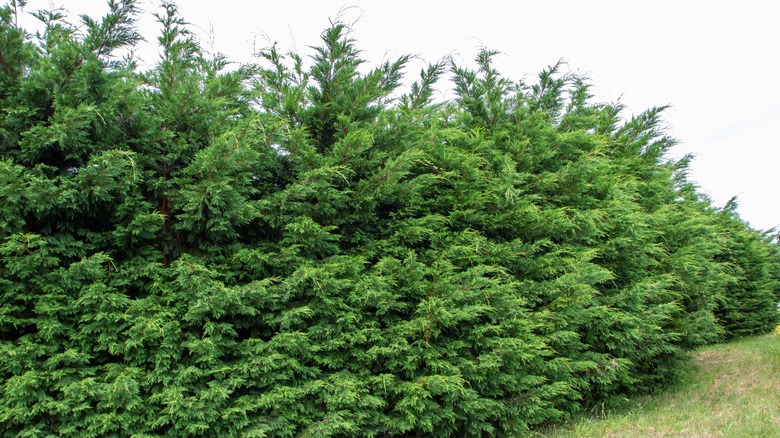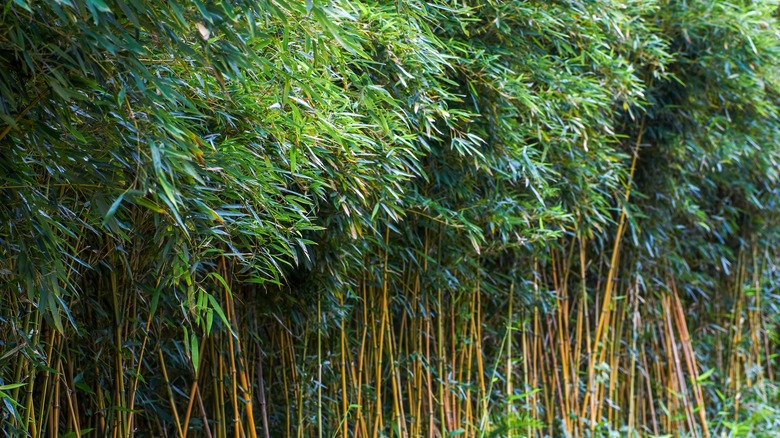Plants To Consider When Looking To Add Privacy To Your Yard
Your front and back yards are an extension of nature that greets you right at your doorstep, but this natural oasis is not always enjoyable when you have snoopy neighbors or curious passersby looking in. Fencing options may be abundant, but what better way is there to make your backyard feel more private than to create a natural screen using plants? These living walls conceal your yard from nosy onlookers, but also provide visual interest and attract wildlife to your property — something fences can't do.
The ideal plants to use as your privacy screen should be able to create an effective visual barrier. Species with densely growing branches, or those with large foliage, are obviously preferable. If you opt for evergreens, you'll have year-round privacy. Evergreens can be coniferous or broadleaf — species as diverse as the northern white cedar, rhododendron, and native bamboo are all evergreen and serve as fantastic privacy plants. Meanwhile, suitable deciduous shrubs, like chokeberry and elderberry, will obscure your outdoor space from view during the months you use it most before shedding their leaves in the fall.
Northern white cedar has a dense crown
Northern white cedar (Thuja occidentalis), also known as American arborvitae, is an evergreen coniferous tree with a large assortment of cultivars offering different canopy shapes. This tree is one of the best hedges you can plant for privacy in your yard because of its densely growing crown, which can grow over 40 feet tall and as wide as 15 feet — if you let it. Apart from concealing your property from the view of passersby, these crowns also serve as a roost for songbirds. So, if you plant these trees strategically, you'll enhance your yard with both a sense of privacy and birdwatching opportunities. Deer also make use of the northern white cedar. Its branches serve as a source of nutrition for the animals during the year's chillier months, and the deer use it as cover and protection from the cold. You, too, can benefit from what effectively becomes a windscreen on the gustier days.
Native to parts of eastern Canada and the Northeastern U.S., northern white cedar can be grown successfully in USDA zones 3A to 7B, but it prefers humid climates to dry ones. If you decide to grow Thuja occidentalis on your property, plant it in a location that receives between two to six hours of sun daily. The tree grows its best in soils that are neither arid nor constantly soaked, and prefers a neutral-to-alkaline growing medium with a high organic content. Loam and clay are both suitable soil candidates for northern white cedar.
Rhododendrons provide privacy and lush blooms in the spring
Rhododendrons are superb candidates for privacy hedging along the property line. These woody shrubs can grow to massive dimensions of up to 10feet in height and up to 8 feet wide, depending on the variety. The large canopies, and the long, broad leaves that stay on the plant year round act as effective shields from nosy neighbors and strangers walking by. Come spring, these shrubs' magnificent blooms create an irresistible display of color. Privacy and visual interest aside, there's another reason to consider planting rhododendrons in your yard — these lush shrubs are also known to attract hummingbirds and pollinators.
Rhododendrons are hardy in USDA zones 4A to 8B. They're understory plants, meaning that they grow under the shady canopies of tall trees in their native habitat. If you choose to plant rhododendrons along the property line to create a privacy hedge, make sure the location is protected from direct sun. If you plant rhododendrons in a bright spot, you risk getting their gorgeous leaves scorched by the sun's rays. Soil matters, too. Although rhododendrons prefer a moist substrate, the soil should drain well, otherwise root rot becomes a distinct possibility. The growing medium should have abundant nutrition and be somewhat acidic, with pH levels of 4.5 to 6.0 being ideal. Keep this requirement in mind if you're planting the shrubs near a concrete paver sidewalk — nearby concrete can affect soil acidity and raise the pH to an unacceptable level for rhododendrons.
Native bamboo species make for an exotic, evergreen privacy screen
Bamboo offers a way to create a natural, year-long privacy buffer on your property quickly. The plant achieves its full height in just two to three months' time, and grows in thick colonies (known as canebreaks). This dense growth habit is perfect for creating a cozy privacy screen around your front or backyard. However, you must be extremely careful and selective with the type of bamboo you choose. That's because most bamboo species are invasive in the U.S., and should not be planted, as a privacy screen or otherwise. We say most because one species of this tree is actually native to North America. Meet Arundinaria gigantea, commonly known as rivercane. This variety of bamboo originates in the southeastern reaches of the nation, where local indigenous cultures have historically used the plant in arts and crafts. Today, the bamboo's population has diminished significantly, and conservation efforts are underway to restore its numbers.
Rivercane bamboo grows anywhere from deep shade to full sun with well-draining, loam-rich soil. If your property abuts a river or other body of water, the bamboo will happily grow along its banks — which it will also protect from erosion. Avoid planting this bamboo in your yard, or in the defensible space of the home if you live along the wildland-urban interface in a region that's prone to wildfires, since Arundinaria gigantea is incredibly flammable.
Chokeberry is a privacy hedge that will also attract birds
Chokeberry is a deciduous shrub that's native to the eastern half of the United States. There are two major species of shrub: the red chokeberry (Aronia arbutifolia) and black chokeberry (Aronia melanocarpa). Although they're not evergreen, both are multi-stemmed, sufficiently large shrubs that can be used as screening if you're looking to add a bit of privacy to the front or backyard.
If you opt to grow red chokeberry, you'll be rewarded with a harvest of edible berries in the late fall and winter. These berries (or, rather, "pomes") make a fine ingredient in jellies and jams. For some reason birds don't enjoy them as much as they love the black chokeberries, so the harvest is all yours. On the other hand, black chokeberry's pomes are less sweet, but typically disappear quicker as birds such as gray catbirds, chickadees, cedar waxwings, and eastern bluebirds flock to the shrubs for a late-fall feast.
Chokeberry is not too picky with soil and sun conditions. They'll tolerate loam and clay soils and a variety of pH levels. Even standing water is not a major problem. Full sun or partial shade is fine, but if you want the shrubs to bear abundant fruit for attracting birds (or for your own harvest), sunnier spots work best. All in all, you should have no trouble growing these species as long as you live in their hardiness zone. This shouldn't be a difficult requirement to satisfy, either. Red chokeberries are hardy in zones 3A to 9B, while their black counterparts thrive in zones 3 to 8.
Elderberry affords privacy, controls erosion, and provides edible fruit
Common elderberry (Sambucus canadensis) is a deciduous shrub that boasts lush foliage, with leaves growing as long and wide as 5 and 2 inches, respectively. The shrub itself grows to a height of 15 feet or more and a width of up to 10 feet. The large leaves, together with its impressive dimensions and tendency to produce new shoots every year make elderberry an excellent plant to use to create a private patio space.
Elderberry is native to much of North America, apart from the Rockies and the Pacific Northwest. This perennial shrub thrives in USDA zones 4A through 8B. Every summer, small but aromatic white flowers adorn the elderberry shrubs, and as fall sets it, they give way to dark purple fruit. You'll notice that as the patio season winds down and fall progresses, elderberry drops its leaves. That said, the densely growing branches should still afford you a degree of privacy. But you don't need to think of your elderberry hedges strictly as a privacy feature. Their fruit is edible when cooked, and you can use it in syrups, jellies, and pies. Meanwhile, elderberry roots serve as a robust erosion control measure in your yard.
Before you plant elderberries as a privacy measure on your property, make sure the intended location gets at least eight hours of sun every day. The soil should be nutrient-rich and well-draining, with a pH of around 6.5. Crucially, the plantings require at least 6 feet of space between them to accommodate the substantial canopies of adult plants.





